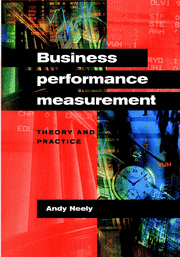Book contents
- Frontmatter
- Contents
- List of contributors
- Preface
- Part I Performance measurement – functional analyses
- 1 Measuring performance: The accounting perspective
- 2 Measuring performance: The marketing perspective
- 3 Measuring performance: The operations perspective
- 4 Finding performance: The new discipline in management
- Part II Performance measurement – theoretical foundations
- Part III Performance measurement – frameworks and methodologies
- Part IV Performance measurement – practical applications
- Part V Performance measurement – specific measures
- Part VI Performance measurement – emerging issues and trends
- Index
1 - Measuring performance: The accounting perspective
from Part I - Performance measurement – functional analyses
Published online by Cambridge University Press: 06 July 2010
- Frontmatter
- Contents
- List of contributors
- Preface
- Part I Performance measurement – functional analyses
- 1 Measuring performance: The accounting perspective
- 2 Measuring performance: The marketing perspective
- 3 Measuring performance: The operations perspective
- 4 Finding performance: The new discipline in management
- Part II Performance measurement – theoretical foundations
- Part III Performance measurement – frameworks and methodologies
- Part IV Performance measurement – practical applications
- Part V Performance measurement – specific measures
- Part VI Performance measurement – emerging issues and trends
- Index
Summary
Introduction
Accounting measures of performance have been the traditional mainstay of quantitative approaches to organizational performance measurement. However, over the past two decades, a great deal of attention has been paid to the development and use of non-financial measures of performance, which can be used both to motivate and report on the performance of business (and other) organizations. The impetus for such developments has come from both the bottom and the top of the organization. Much performance management at the operational level is carried out using specific indicators of performance, which are usually not measured in financial terms. At the most senior levels, although financial performance is inevitably a major consideration, there has been increasing recognition that other important factors in the effective running of the organization cannot be well captured by such measures. Thus, non-financial performance measures have undergone significant development, to the relative neglect of the development of improved financial measures. However, the recent publicity surrounding the marketing of economic value added (EVA®) as an overall measure of company performance by management consultants Stern Stewart can be seen as a sign of a new emphasis on the financial aspects of performance.
The purpose of this contribution is to review the roles and functions of financial measures of organizational performance, and to outline the major features of their development, particularly in the latter half of the last century. It will be argued that there are three different major functions for financial performance measures, and that, although these functions overlap to some extent, major confusion can be caused by applying measures developed for one function to a different one.
- Type
- Chapter
- Information
- Business Performance MeasurementTheory and Practice, pp. 3 - 21Publisher: Cambridge University PressPrint publication year: 2002
- 23
- Cited by



